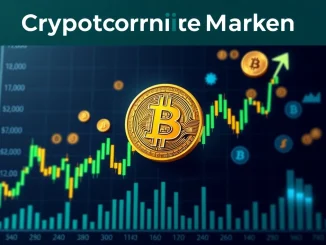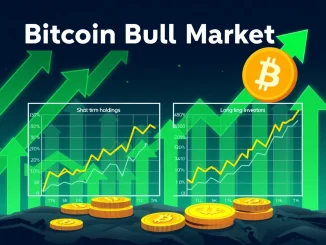
Cryptocurrency markets are known for their volatility, but recent data has sent ripples of concern through the investment community. A significant shift has been observed in the U.S. spot Bitcoin ETFs, with a massive outflow of funds signaling potential market jitters. Let’s dive into the details of this unprecedented event and understand what it could mean for the future of Bitcoin and the broader crypto landscape.
Unprecedented $757 Million Net Outflow from Spot Bitcoin ETFs
February 26th will be marked as a notable day in the history of spot Bitcoin ETFs in the United States. Data reveals a combined net outflow of a staggering $757.03 million. This marks not only the seventh consecutive day of net outflows but also the largest single-day net outflow ever recorded. This information, initially highlighted by Trader T (@thepfund) on X, has triggered widespread discussion and analysis within the crypto and financial sectors.
To put this number into perspective, $757.03 million isn’t just a minor fluctuation; it’s a substantial movement of capital out of these investment vehicles. This outflow raises critical questions about investor sentiment and the immediate future of Bitcoin’s price trajectory.
Which Bitcoin ETFs are Experiencing the Largest Outflows?
Breaking down the data, we can see which specific Bitcoin ETFs are contributing most significantly to this overall net outflow. Here’s a detailed look at the performance of key ETFs on February 26th:
| ETF Provider | ETF Ticker | Net Outflow (USD) |
|---|---|---|
| BlackRock | IBIT | $420.56 Million |
| Fidelity | FBTC | $145.69 Million |
| ARK Invest | ARKB | $60.46 Million |
| Grayscale | GBTC (Mini BTC) | $55.97 Million |
| Grayscale | GBTC (Original) | $22.66 Million |
| Invesco | BTCO | $16.83 Million |
| Bitwise | BITB | $13.65 Million |
| WisdomTree | BTCW | $11.52 Million |
| Franklin Templeton | EZBC | $9.69 Million |
As the table illustrates, BlackRock’s IBIT ETF experienced the most significant outflow, accounting for a large portion of the total. Fidelity’s FBTC followed, with ARKB, Grayscale’s mini BTC, and the original GBTC also contributing to the substantial net outflows. It’s important to note that while these ETFs saw significant movements, the remaining ETFs in the market reported minimal changes in their holdings.
What Factors are Driving These Net Outflows?
The question on everyone’s mind is: why are we witnessing such massive net outflows from spot Bitcoin ETFs? Several factors could be at play, and it’s likely a combination of these that’s contributing to the current trend:
- Profit Taking: After a period of price appreciation in Bitcoin, some investors may be taking profits, especially those who invested early in these ETFs.
- Market Correction Fears: Concerns about a potential market correction in the broader cryptocurrency space or even in traditional markets could be prompting investors to reduce their exposure to riskier assets like Bitcoin.
- Macroeconomic Uncertainty: Global economic conditions, including inflation, interest rate hikes, and geopolitical events, can influence investor sentiment and lead to shifts in investment strategies.
- GBTC Outflows Persisting: Grayscale’s GBTC has been experiencing consistent outflows since its conversion to an ETF, partly due to its higher fees compared to newer ETFs. This ongoing trend is still contributing to the overall negative flow.
- Rotation to Other Assets: Investors might be reallocating funds to other asset classes that they perceive as more attractive at the moment, such as certain altcoins, stocks, or even bonds.
Impact on Bitcoin Price and Market Sentiment
Significant net outflows from spot Bitcoin ETFs can exert downward pressure on the Bitcoin price. When ETFs sell Bitcoin to meet redemption requests from investors withdrawing their funds, it increases selling pressure in the market. This can lead to price corrections and impact overall market sentiment.
Furthermore, prolonged periods of outflows can erode investor confidence. If the trend continues, it could signal a broader shift in market sentiment, potentially leading to further price declines and increased volatility in the short to medium term. However, it’s crucial to remember that the cryptocurrency market is dynamic and can be influenced by numerous factors.
Analyzing the ETF Market Landscape
The launch of spot Bitcoin ETFs in the U.S. was initially hailed as a landmark event, expected to bring institutional capital and mainstream adoption to Bitcoin. While these ETFs have indeed attracted significant investment, the recent outflows highlight the inherent volatility and complexities of the crypto market.
It’s essential to analyze the ETF market landscape beyond just daily flows. Factors to consider include:
- Long-Term Investment Thesis: Are investors still confident in the long-term investment thesis for Bitcoin? Outflows could be short-term reactions to market conditions or could indicate a shift in long-term perspectives.
- ETF Competition and Fees: The ETF market is competitive, with varying fee structures and fund management strategies. Outflows from certain ETFs could be due to investors migrating to lower-fee options or funds with different strategies.
- Regulatory Developments: Evolving regulatory landscapes can impact investor sentiment and ETF flows. Any significant regulatory changes could trigger shifts in market dynamics.
- Institutional vs. Retail Investors: Understanding the behavior of different investor segments (institutional vs. retail) within these ETFs is crucial. Large institutional outflows can have a more significant impact on market prices.
What’s Next for Bitcoin ETFs and the Crypto Market?
The $757 million Bitcoin ETF outflow is undoubtedly a significant event that warrants close attention. While it raises concerns about short-term market pressures, it’s important to maintain a balanced perspective. The cryptocurrency market is known for its cyclical nature, and periods of correction are often followed by renewed growth phases.
Moving forward, it will be crucial to monitor:
- Daily ETF Flows: Tracking daily flows will provide insights into whether the outflow trend is continuing or if it’s a temporary phenomenon.
- Bitcoin Price Action: Observing how Bitcoin’s price reacts to these outflows and broader market conditions will be critical.
- Macroeconomic Indicators: Keeping an eye on macroeconomic factors and global economic news will help understand the broader context influencing investor decisions.
- Regulatory Updates: Staying informed about any regulatory developments that could impact the crypto market and ETF landscape is essential.
Conclusion: Navigating the Volatile Waters of Crypto ETFs
The record Bitcoin ETF outflow of $757 million serves as a stark reminder of the inherent volatility and dynamic nature of the cryptocurrency market. While these outflows are concerning and could signal short-term market pressures, they also present an opportunity for investors to reassess their strategies and for the market to potentially consolidate before the next phase of growth. Staying informed, understanding market dynamics, and maintaining a long-term perspective are key to navigating the exciting yet often turbulent world of crypto investments.



